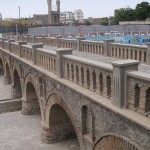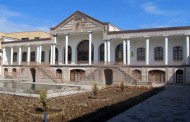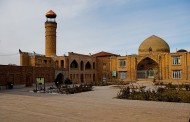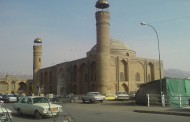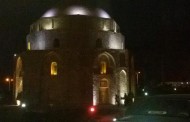Tabriz pronounced [tæbˈriːz] is the most populated city in the northwest of Iran, one of the historical capitals of Iran, and the present capital of East Azerbaijan Province. Tabriz is located at an elevation of 1,350 meters above sea level in the Quru River valley between the long ridge of the volcanic cones of the Sahand and Eynali mountains. The valley opens up into a plain that gently slopes down to the eastern shores of Lake Urmia, 60 kilometres (37 miles) to the west. With cold winters and temperate summers, the city is considered a summer resort.
Tabriz has a population of 1,549,453. It is a major heavy industry hub for automobile, machine tools, refineries and petrochemical, textile, and cement production industries. Tabriz is also a site for some of the most prestigious academic and cultural institutes in the northwest of Iran.
The city has a long and turbulent history with its oldest civilization sites dated back to 1,500 B.C. It contains many historical monuments representing the transition of Iranian architecture in its long historical timelines. Most of the preserved historical sites in the city are belong to Ilkhanid (of Mongol Empire), Safavid, and Qajar area, among them is the grand Bazaar of Tabriz which is inscribed as a World Heritage Site in 2010. From the early modern era and on, the city has proven to be pivotal in the development, movement, history, and economy of three neighboring regions, namely that of the Caucasus, Eastern Anatolia, and central Iran. From the 19th century and on, it became the most important city in the country in numerous respects. As the closest Iranian hub to Europe, many aspects of the early modern modernisation in Iran started in Tabriz. Prior to the forced ceding of Iran’s Caucasian territories to Imperial Russia following the two Russo-Persian Wars of the first half of the 19th century, Tabriz was the main city in the legisture of Iranian rule for its Caucasian territories due to its proximity. During almost the entire Qajar period (up to 1925), it functioned as the seat for the crown prince as well.
The early history of Tabriz is currently not well-documented. Some archaeologists suppose that the Garden of Eden was probably located in present-day location of Tabriz. The earliest known inscription about Tabriz, referring to the city as Tarui or Tauris is on the Assyrian King Sargon II’s epigraph in 714 BC. Tabriz has been chosen as the capital for some rulers commencing from Atropates era and his dynasty.
A recent excavation at the site of the Iron Age museum, in the north of the Blue Mosque site, uncovered a grave yard of 1st millennium BC. More likely the city has been destroyed several times either by natural disasters or by the invading armies.
The earliest elements of the present Tabriz are claimed to be built either at the time of the early Sassanids in the 3rd or 4th century AD, or later in the 7th century. The Middle Persian name of the city was T’awrēš.
After the conquest of Iran by Muslims, the Arabic Azd tribe from Yemen resided in Tabriz. The development of post-Islamic Tabriz began as of this time. The Islamic geographer Yaqut al-Hamawi says that Tabriz was a village before Rawwad from the tribe of Azd arrive at Tabriz.In 791 AD, Zubaidah, the wife of Abbasid caliph Harun al-Rashid, rebuilt Tabriz after a devastating earthquake and beautified the city so much as to obtain the credit for having been its founder.
After the Mongol invasion, Tabriz came to eclipse Maragheh as the later Ilkhanid Mongol capital of Azerbaijan until it was sacked by Timur in 1392.
Chosen as a capital by Abaqa Khan, fourth ruler of the Ilkhanate, for its favored location in the northwestern grasslands, in 1295, his successor Ghazan Khan made it the chief administrative center of an empire stretching from Anatolia to the Oxus River and from the Caucasus to the Indian Ocean. Under his rule new walls were built around the city, and numerous public buildings, educational facilities, and caravansarais were erected to serve traders traveling on the ancient Silk Road. The Byzantine Gregory Choniades is said to have served as the city’s Orthodox bishop during this time.
In the 13th century many western expediters who visit Tabriz on their way to the east were amazed by the richness of the city, its magnificent buildings and its institutions.
Marco Polo, who traveled thorough the Silk Road and passed Tabriz about 1275, described it as: “a great city surrounded by beautiful and pleasant gardens. It is excellently situated so the goods brought to here come from many regions. Latin merchants specially Genevis go there to buy the goods that come from foreign lands.”
During the Middle Ages, a Jewish community existed in the town. In the 16th century a Jewish Yemenite traveler to the town described the deteriorating conditions of Jewish life there.
From 1375 to 1468, Tabriz was the capital of Qara Qoyunlu state in Azerbaijan, until defeat of Qara Qoyunlu ruler, Jahan Shah by Ag Qoyunlu warriors. Ag Qoyunlus selected Tabriz as their capital from 1469 to 1501. Some of the existing historical monuments including the Blue Mosque belong to the Qara Qoyunlu period.
In 1501, Shah Ismail I entered Tabriz and proclaimed it the capital of his Safavid state. In 1514, after the Battle of Chaldiran, Tabriz was temporarily occupied by the Ottomans, but remained the capital of Safavid Iranian empire until 1548, when Shah Tahmasp I transferred it to Qazvin to avoid the growing threat of Ottoman army.
Between 1585 and 1603, Tabriz was occupied by the Ottomans before it was liberated by the Safavid king, Abbas I of Persia after which it grew as a major commercial center, conducting trade with the Ottoman Empire, Russia, and the Caucasus.
In summer of 1721, a large earthquake shocked Tabriz, killing about eighty thousand of its residents. The devastation continued later on 1724-1725 by the crucial invasion of the city by Ottoman army during which they imprisoned and killed about two hundred thousand of Tabriz inhabitants. The city was retaken later by the Iranian army. In coming years the widespread hunger and disease killed more of the city’s residents. In 1780, a major earthquake hit near Tabriz killing over 200,000 people. The tragic devastation reduced the number of inhabitants to about thirty thousand and turned the city to a mere ghost town.
At the end of the 18th century the city was divided to several districts each of which was ruled by a family, until 1799 when the Qajar Prince Abbas Mirza was appointed as the governor of the city. During the Qajar dynasty the city was the residence for the Crown Prince. The crown prince normally served as governor of Azerbaijan province as well. One of the most important events in this period was the war between Iran and Russia. With the last series of the Russian-Iranian wars, the city was captured by Russia in 1827 by General Prince Eristov, who marched into the city with 3,000 soldiers. After Abbas Mirza and Ivan Paskevich signed the peace treaty the Russian army retreated from the city however the Russian political and military influence remained a major thing in Tabriz and north-northwestern Iran up to the fall of Russian empire in the early 20th century. After the retreat of the Russian army, Abbas Mirza, Qajar prince of crown, started a modernization scheme launched from Tabriz. He introduced Western-style institutions, imported industrial machinery, installed the first regular postal service, and undertook military reforms in the city. He rebuilt the remnants of Tabriz and established a modern taxation system.
- Painting of Blue mosque, Jules Laurens, 1872.
- Skyline of Tabriz sketched in 1673, Jean Chardin.
- Sketch of gate of Tabriz, Eugène Flandin 1841.
- A sketch of a 19th-century house in Tabriz, Eugène Flandin.
Tabriz was chosen as the capital by several rulers commencing from the time of Atropates. It was the capital of the Ilkhanate (Mongol) dynasty since 1265. During the Ghazan Khan era, who came into power in 1295, the city reached its highest splendour. The later realm stretched from the Amu Darya in the East to the Egypt borders in the West and from the Caucasus in the North to the Indian ocean in the South. It was again the capital of Iran during the Qara Qoyunlu dynasty from 1375 to 1468 and then during the Ag Qoyunlu within 1468–1501. Finally, it was capital of the Iranian Empire in the Safavid period from 1501 until their defeat in 1555.
During the Qajar dynasty, Tabriz was used as residence center of Iranian Crown Prince (1794–1925).
Attractions
Tabriz was devastated by several earthquakes during its history (e.g., in 858, 1041, and 1721) and as a result, from numerous monuments only few of them or part of them have survived until now. Moreover, some of the historical monuments have been destroyed fully or partially within construction projects (e.g. the Ark of Tabriz is in danger of destruction now, because of ongoing construction project of “Mosal’laye Emam” in close proximity). Nonetheless, there are still numerous monuments remaining until now, which include:
- Aji Chay Bridge
- Amir Nezam House (Qajar museum)
- Arg of Tabriz
- Azerbaijan Museum
- Baghmasha gate
- Bazaar of Tabriz, a world heritage site.
- Behnam House (school of architecture)
- Blue Mosque (Goy Masjid)
- Boulourchian house
- Catholic church of Tabriz
- Constitutional Revolution House of Tabriz (Mashrouteh museum)
- Daneshsara (faculty of education)
- Document Museum
- East-Azerbaijan State Palace
- Ferdowsi street
- Ghadaki house
- Qari bridge
- Haidarzadeh house
- Hariree house
- House of Seghat ol Islam
- Imamzadeh Hamzah, Tabriz
- Imamzadeh Ibrahim
- Iranian municipalities
- Iron Age museum
- Jameh mosque of Tabriz
- Madrasah Akbarieh
- Maqbaratoshoara (tomb of poets)
- Mansoor bridge
- Measure museum
- Muharram museum
- Municipality of Tabriz
- Bohtouni museum
- Tabriz Museum of Natural History
- Nobar bath
- On ibn Ali’s shrine
- Ordobadi house
- Pahlavi street (Imam St.)
- Pol Sanghi (Stone bridge)
- Pottery museum
- Post museum
- Qur’an museum
- Roshdieh school
- Rug museum
- Ruins of Rabe Rashidi University
- Saheb ol Amr mosque
- Saint Mary Church of Tabriz (Armenian church of)
- Salmasi house
- Seventh-day Adventist Church Armenian
- Shahnaz street
- Shahryar literature museum (house of Shahryar)
- Sharbatoglu house
- Shohada Mosque
- Sorkheh-i house
- Tabriz Fire Fighting Tower
- Tabriz Railway Station
- Tarbiyat street
- Two Kamals tomb
- Saint Mary Church of Tabriz
- Seyed Hamzeh shrine & mosque.
- Museum of Azerbaijan
- The grand Bazaar
- Blue Mosque
- Behnam House
- Constitution House of Tabriz
- Chay kenar (river side) at night.
- El-Gölü (or Pars) Hotel
- Saat Tower
- Measure museum of Tabriz
- Amir Nezam House (Qajar museum)
- Ghari bridge
- Iron Age museum
- Shah-goli park.
Parks and gardens
Tabriz has 132 parks, including 97 small parks, 31 regional and 4 city parks. According to 2005 statistics, area of parks in Tabriz is 2,595 km2 also area of green spaces of Tabriz is 8,548 km2, which means 5.6 sq.m per person. The oldest park in Tabriz, called Golestan Baği, was established at first Pahlavi’s era in city center. Tabriz has 8 traveler-parks with capacity of 10.000 travelers, as well.
- Baghlarbaghi
- Khaqani Park
- Ghaem Magham
- Golestan Park
- Mashrouteh Park
- Saeb Tabrizi garden
- Shah Goli park
- Shams Tabrizi garden
- Eynali state forest park.
- Baghmesha park.
An interesting park-like popular location is Eynally Daği, a mountain at the north-east extremity of the city. Eynali was a barren mountain on top of which there was a huge white rectangular antenna facing Tabriz city. The old building was claimed to be a shrine that housed the burial site of an Imamzadeh (a descendant of the profit of Islam). In recent years trees have been planted on mountain slopes and the place has the appearance of a vast park. Every Friday morning many walk the site to enjoy the relatively cleaner breezes and watch the ever growing jungle of highrise buildings on the flat, arid plateau. Generally, the brief picnic ends with drinking a few cups of tea that has been brewed on a smoking fire. Making fire is a challenge as the scanty vegetation consists of trees that have been planted in recent years and are jealously guarded behind barbed wires. However, the crowds enjoy the challenge as a pleasant part of the weekly ritual. In older times, only groups of young men would climb near the shrine. In more recent years the presence of women is noticeable.
- Eynali artificial forest in north of the Tabriz.
- Shah Goli Park
- A Week-end Ritual at Eynali peak.
TOP SIGHTS IN TABRIZ
Tabriz Historic Bazaar Complex
Tabriz has been a place of cultural exchange since antiquity and its historic bazaar complex is one of the most important commercial centres on the Si... Read more
Aji Chay Bridge
Aji Chy Bridge is one of the oldest bridges Northwest of Tabriz on the Aji Chay river. This bridge was connecting Tabriz to the North of Azerbaijan. I... Read more
Amir Nezam House
The Amir Nezām House (Persian: Khaneh-e Amir Nezām, Azeri: Emir Nizamin evi), or The Qajar Museum of Tabriz, is a historical building in the Sheshghe... Read more
Arg of Tabriz
Arg-e AliShāh, also known as Arg-e Tabriz, Arch of Alishah, Arg Citadel, and Masjid AliShāh, is remnants of a big unfinished 14th century mausoleum an... Read more
Azerbaijan Museum
Azerbaijan Museum is the major archaeological and historical museum in Tabriz, in the northwest part of Iran (East Azerbaijan province). It was establ... Read more
Behnam House
Behnam House is a historical building in Tabriz, Iran. The edifice was built during the later part of the Zand dynasty (1750–1794) and the early part... Read more
Blue Mosque, Tabriz
The Blue Mosque (Azerbaijani: Göy məscid; Persian: Masjed-e Kabūd) is a famous historic mosque in Tabrīz, Iran. The mosque and some other public buil... Read more
Constitution House of Tabriz
Constitution House of Tabriz, also known as Khaneh Mashrouteh or khaneh Abolmeleh, is a historical edifice located next to the Great Bazaar of Tabriz,... Read more
East Azerbaijan Governance Palace
East-Azerbaijan State Capitol,is the main office for Iran’s East-Azerbaijan province governor in city center of Tabriz. The history of the locat... Read more
Qari Bridge
The Qari Bridges are two historic stone bridges over the Quri River in Tabriz, Iran. Because of their age, currently both of the bridges have been clo... Read more
Haidarzadeh house
Haidarzadeh’s house is a historical mansion situated in Maghsoudieh suburb of Tabriz, Iran, on the south side of Tabriz Municipality building. There i... Read more
Hariri house
The Dr,Hariri house is related to the Qajar period, and in No. 132, Noor Hashemi Alley, Tarbiyat street, Tabriz, This house was recorded in Iran... Read more
House of Seghat ol Islam
House of Seghat ol Islam is a historical house in Tabriz, Iran, now a museum dedicated to Seghat ol Islam who was a local reformist of the Qajar era. Read more
Imamzadeh Hamzah, Tabriz
Imāmzādeh Hamzah is an Imamzadeh mosque complex in Tabrīz, Iran. The mosque contains the grave of Hamzah, son of the Twelver Shī‘ah Imām, Mūsā’... Read more
Iron Age museum
The Iron Age Museum is a museum in Tabriz, north-western Iran, which covers an area of 28,290 m². It is located on the north, northwest and northeast... Read more
Jameh Mosque of Tabriz
The Jāmeh Mosque (Persian: Masjid-e-Jāmeh Tabrīz) is a large, congregational mosque (Jāmeh) in Tabrīz, within the East Azerbaijan Province of Iran. It... Read more
Madrasah Akbarieh
Madraseye Akbarieh was an old school in Tabriz, north-western Iran. Read more
Maqbaratoshoara
Maqbarat-o-shoara or the Mausoleum of Poets (Persian: Mazār e Shāerān or Mazār e Sorāyandegān) belongs to poets, mystics and famous people, located... Read more
Measure museum
The Measure Museum of Tabriz is in the Salmasi House. The museum has a variety of weighing tools such as goldsmith, large balance of field vegetables,... Read more
Muharram museum
Muharram museum is an anthropological museum in Tabriz, in the East Azerbaijan province, Iran. As it is known, anthropology is the study of people’s c... Read more
Saat Tower
Sa’at Tower also known as Tabriz Municipality Palace is the head office of the municipal government of Tabriz, the capital of East Azarbaijan Pr... Read more
Museum of Ostad Bohtouni
Museum of Ostad Bohtouni is a museum in Tabriz, north-western Iran. Handcrafts of artist Bohtouni are kept in this museum, including sculptures of dif... Read more
Tabriz Museum of Natural History
Tabriz Museum of Natural History is a museum of wild life in the city of Tabriz at north western Iran, established in 1993 by Department of Environmen... Read more
Nobar bath
The Nobar bath is one of the historical baths of Tabriz, Iran. It has been constructed in the centre of the city, near the Nobar gate which was one of... Read more
On ibn Ali’s shrine
On ibn Ali’s shrine is a shrine over Eynali mountain to north of Tabriz, Iran. Some historians believe the shrine belongs to two Muslim clerics.... Read more
Pottery museum of Tabriz
The Pottery museum is an art museum in Tabriz, Iran, established in one of the historical houses of the city known as Sarraflar’s house, which belongs... Read more
Rab’-e Rashidi
Rab’-e Rashidi was an academic campus in North Eastern part of city Tabriz, constructed in late 13th century during king Ghazan, ruler of Ilkhan... Read more
Saheb-ol-Amr Mosque
The Sāheb ol Amr Mosque (Persian: Masjid-e Sāheb ol Amr) or King Tahmasp Mosque is a mosque located on the east side of Saaheb Aabaad square in Tabriz... Read more
Saint Mary Church of Tabriz
The Saint Mary’s Armenian church is an Armenian Christian church located in Tabriz, East Azerbaijan Province, Iran. It is the largest and oldest... Read more
Tabriz Fire Fighting Tower
The Tabriz Fire Fighting Tower (also Yangin Tower; ) is a fire fighting tower in Tabriz, Iran. The tower, standing at 23 m, was built in 1917 . It was... Read more
Tabriz railway station
Tabriz railway station is a structure in Tabriz, Iran; the current building was built during second Pahlavi era by Iranian architect Heydar Ghiaï-Cham... Read more
Tomb of Two Kamals
The Tomb of Two Kamals, or in short the 2-Kamal Tomb, is a funerary monument in Tabriz, Iran. Two Kamals – the 14th-century poet Kamal Khujandi and th... Read more
Khaqani Park
Khaqani Park or Boostan Khaqani is a small park which is located between Azerbaijan Museum and Blue mosque in Tabriz. The park named after 12th centur... Read more
Golestan Park
Golestan Park is a historical park in Tabriz, Iran. The park is located near to Qonqa Square in city center. The place, which was originally used as a... Read more




















